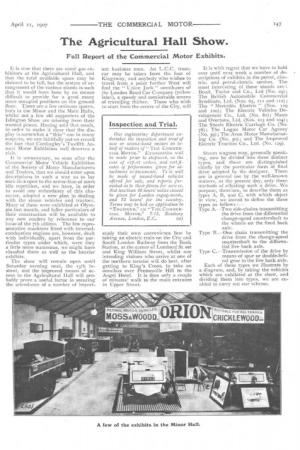The Agricultural Hall Show.
Page 15

If you've noticed an error in this article please click here to report it so we can fix it.
Full Report of the Commercial Motor Exhibits.
It is true that there are some' 400 exhibitors at the Agricultural Hall, and that the total available space may be claimed to be full, but the system of arrangement of the various stands is such that it would have been by no means difficult to provide for a good many more occupied positions on the ground floor. There are a few ominous spaces, both in the Minor and the Main Halls, whilst not a few old supporters of the Islington Show are missing from their wonted places. Having said that much, in order to make it clear that the display is somewhat a "thin" one in many respects, we can faithfully put on record the fact that COrdingley's Twelfth Annual Motor Exhibition well deserves a
It is unnecessary, so soon after the Commercial Motor Vehicle Exhibition of the Society of Motor Manufacturers and Traders, that we should enter upon des=iptions in such a way as to lay oursivcs open to the accusation of mere idle repetition, and we have, in order to avoid any redundancy of this character, adopted a new plan in dealing with the steam vehicles and tractors. Many of these were exhibited at Olympia last month, and fuller particulars of their construction will be available to any new readers by reference to our issue of the 7th ultimo. The few representative machines fitted with internalcombustion engines are, however, dealt with individually, apart from the particular types under which, were they a little more numerous, we might have classified them as well as the heavier exhibits.
The show will remain open until Saturday evening next, the t3th instant, and the improved means of access to the Agricultural Hall will probably prove a useful factor in securing the attendance of a number of import ant business men. An L.C.C. tramcar may be taken from the foot of Kingsway, and anybody who wishes to travel from a point further West will find the " Union Jack " omnibuses of the London Road Car Company (yellow label), a speedy and comfortable means of travelling thither. Those who wish to start from the centre of the City, will study their own convenience hest by taking an electric train on the City and South London Railway from the Bank Station, at the earner of Lombard St_eet and King William Street, whilst any intending visitors who :arrive at one of the northern termini will do best, after getting to King's CroSs, to take an omnibus over Bentonville Hill to the Angel Hotel. It is then only a couple of minutes' walk to the main. entrance in Upper Street.
It is with regret that we have to hold over until next week a number of descriptions of exhibits in the petrol, electric, and petrol-electric section. The most interesting of these stands are : Boult, Taylor and Co., Ltd (No. 29); The British Automobile Commercial Syndicate, Ltd. (Nos. 6s, tit and 112); The " Mercedes Electric " (Nos. 119 and 120); The Electric Vehicles Development Co., Ltd. (No. 82); Mann and Overtons, Ltd. (Nos. 103 and 104); The Sheds Electric Carriage Co. (No. 78); The Logan Motor Car Agency (No. 59); The Avon Motor Manufacturing Co. (No. 50); and The Improved Electric Traction Co., Ltd. (No. 129).
Steam wagons may, generally speaking, now be divided into three distinct types, and these are distinguished chiefly by the particular form of final drive adopted by the designer. There are in general use by the well-known makers, at the present day, only three methods of effecting such a drive. We purpose, therefore, to describe them as types A, B, and C, with which object in view, we intend to define the three types as follows :— Type A.--Two side-chains transmitting
the drive from the differential change-speed countershaft to the wheels on the fixed back axle.
Type B.—One chain transmitting the drive from the change-speed countershaft to the differential live back axle.
Type C.—Transmission of the drive by means of spur or double-helical gear to the live back axle. Each of these types we illustrate by a diagram, and, by taking the vehicles which are exhibited at the show, and dividing them into types, we are enabled to carry out our scheme.






























































